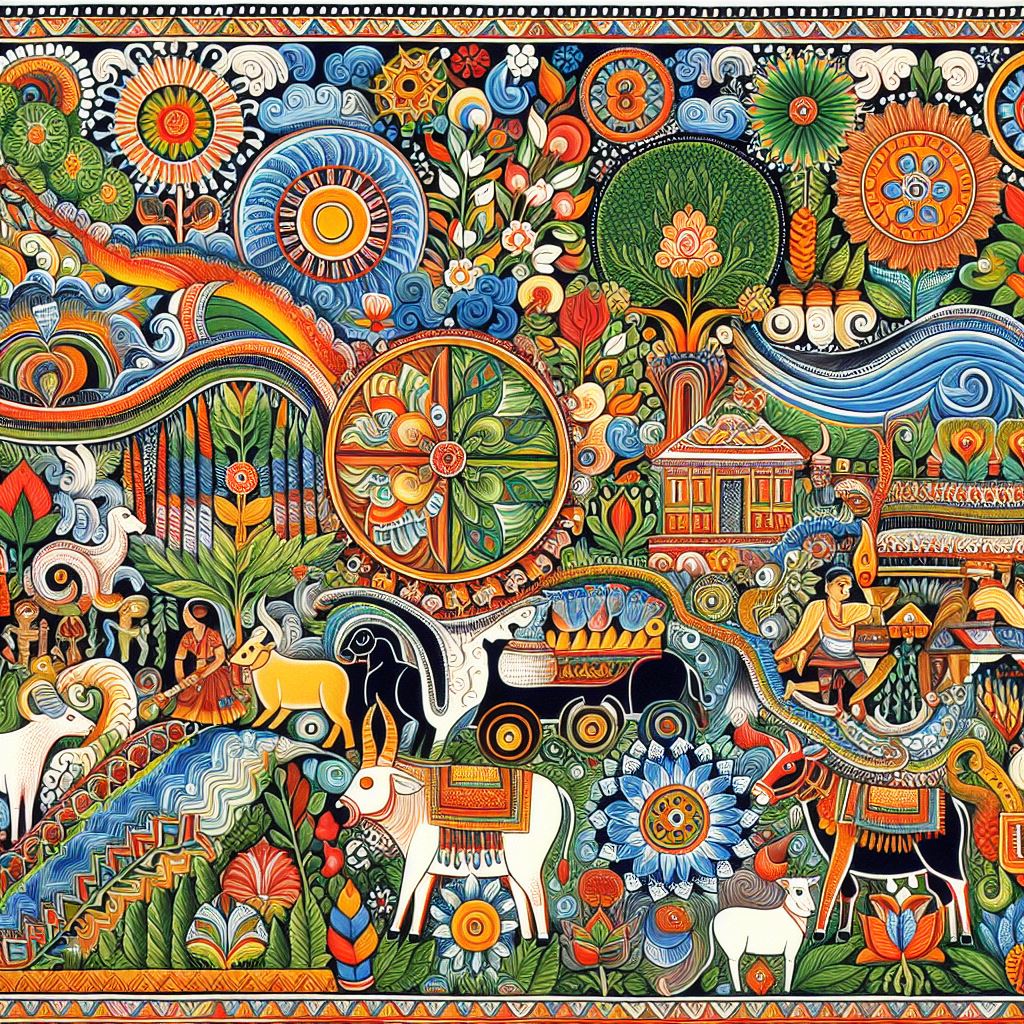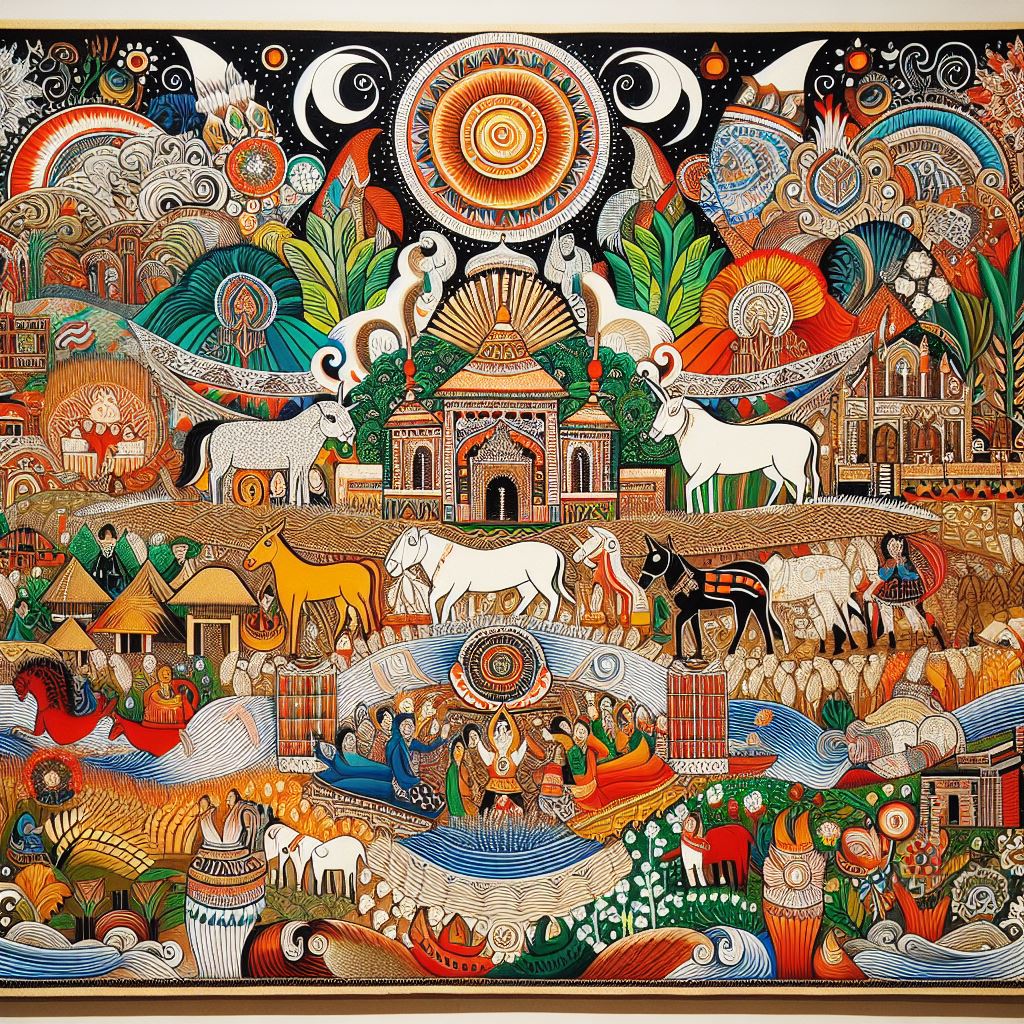Mithila paintings, also known as Madhubani paintings, are a form of traditional art that originated in the Mithila region of Bihar in India. These paintings are characterized by their vibrant colours, intricate patterns, and traditional themes. Mithila paintings have been a part of the cultural heritage of the region for centuries and continue to be revered by art enthusiasts around the world. In this article, we will take a closer look at the history, evolution, techniques, themes, and cultural significance of Mithila paintings, along with the challenges faced in preserving and promoting this unique art form.

Introduction to Mithila Paintings
What are Mithila Paintings?
Mithila paintings, also known as Madhubani paintings, are a form of traditional Indian folk art that originated in the Mithila region of Bihar and Nepal. These paintings are characterized by their brightly coloured, intricate designs and are made using natural pigments and a variety of tools and techniques.
The Origin of Mithila Paintings
Mithila paintings have a rich history that dates back to prehistoric times. It is believed that women from the Mithila region used to decorate their homes with these paintings, particularly during weddings and festivals, to celebrate special occasions. Over time, Mithila paintings evolved from simple wall designs to complex pieces of art, and today they are revered for their beauty and cultural significance.
History and Evolution of Mithila Paintings
Prehistoric Mithila Paintings
The earliest Mithila paintings can be traced back to the prehistoric era, as evidenced by the rock paintings found in the caves of the Bhimbetka region in Madhya Pradesh. These paintings depict scenes from everyday life, such as hunting and dancing, and are thought to be over 2,500 years old.
Evolution of Mithila Paintings
Over time, Mithila paintings evolved to reflect the religious beliefs and cultural practices of the region. They became more elaborate and detailed, with a wide range of themes and motifs, including stories from Hindu mythology, nature, and everyday life in rural Bihar.
Themes and Motifs in Mithila Paintings

Nature in Mithila Paintings
Nature plays an important role in Mithila paintings, with trees, flowers, birds, and animals serving as common motifs. These elements are often depicted in bright, vibrant colours and are used to symbolize growth, fertility, and prosperity.
Religious Significance in Mithila Paintings
Religion also plays an important role in Mithila paintings, with many pieces depicting scenes from Hindu mythology. These paintings are often used as a form of worship and are believed to bring good fortune and blessings to the home.
Tools and Techniques Used in Mithila Paintings
Different Types of Tools Used in Mithila Paintings
Mithila paintings are made using a variety of tools, including bamboo pens, twigs, and fingers. Natural pigments are used to create colourful designs, with colours obtained from flowers, bark, leaves, and even cow dung.
Techniques Used in Mithila Paintings
Mithila paintings are made using a variety of techniques, including the “line and colour fill” method, in which outlines are first drawn using a bamboo pen or twig, and then filled in with colours. Another technique is the “finger painting” method, in which natural pigments are applied to the painting using the fingers. These techniques require a great deal of skill and precision, and the resulting paintings are truly stunning works of art.
Prominent Mithila Painters and Their Work
Mithila paintings originated in the Mithila region of Bihar and carry a rich history and cultural significance. Here are some prominent Mithila painters and their work:
Dulari Devi
Dulari Devi is a well-known Mithila painter who has contributed to the art form for over three decades. Her work mostly revolves around themes like nature, religion, and mythology. Intricate line work, vibrant colours, and intricate detailing are hallmarks of her paintings.
Sita Devi
Sita Devi is another prominent Mithila painter who has been actively involved in the art form for over four decades. Her paintings are known for their vibrant colours, intricate detailing, and unique perspective on the themes she portrays. Her work often revolves around social issues like women’s empowerment and gender equality.
Contemporary Trends
Mithila paintings have come a long way since their inception, and contemporary trends in the art form reflect that. Here are some changes in the themes and styles of Mithila paintings in recent times:
Changing Themes and Styles
Traditionally, Mithila paintings were done on mud walls and floors and mostly depicted scenes from Hindu mythology. However, with the advent of new mediums, themes have changed, and new styles have emerged. Contemporary Mithila paintings now feature a broad range of subjects, from rural life to social issues and modern-day concerns.
Mithila Paintings in Modern Times
In modern times, Mithila paintings have found their place in the mainstream art world. Many artists have taken up Mithila paintings as a full-time profession, and the art form has gained recognition at national and international levels. Modern technology has also helped in preserving and promoting this ancient art form.
Significance and Cultural Value
Mithila paintings hold immense cultural significance, and their values go beyond just art. Here are some ways Mithila paintings are vital to Indian culture:
Mithila Paintings in Religion and Rituals
Mithila paintings have been an essential part of religious rituals and ceremonies in the Mithila region. The paintings are used to decorate the walls of homes during events like weddings, births, and festivals. Mithila paintings have also been used to depict scenes from Hindu mythology and have been a part of religious practices for centuries.
Mithila Paintings and Women Empowerment
Mithila paintings have played a significant role in women’s empowerment in the Mithila region. Traditionally, women were not allowed to participate in the public sphere, but Mithila paintings provided a way for women to express themselves creatively. Many women in the region have taken up Mithila paintings as a profession, which has helped them gain financial independence and social recognition.
Preserving and Promoting the Paintings: Challenges and Opportunities
Mithila paintings are not just an art form; they are also a vital cultural heritage. It is essential to preserve and promote this ancient art form for future generations. Here are some challenges and opportunities in preserving and promoting Mithila paintings:
Challenges in the Preservation
The biggest challenge in preserving Mithila paintings is their vulnerability to environmental factors like moisture, sunlight, and pests. Mithila paintings are traditionally done on mud walls and floors, which makes them prone to wear and tear. The lack of proper preservation techniques and facilities further adds to the challenge.
Opportunities for Promoting Mithila Paintings
Promoting Mithila paintings can be a significant source of income for the artists, and it can help preserve the art form for future generations. Mithila paintings have gained recognition at national and international levels, and many organizations are working towards preserving and promoting the art form. Moreover, modern technology has provided new avenues for promoting Mithila paintings, such as online marketplaces and social media platforms.

Conclusion
In conclusion, Mithila paintings are a beautiful and unique form of traditional art that holds immense cultural significance. Despite the challenges of preservation and promotion, the art form continues to thrive and capture the imagination of art lovers around the world. By understanding and appreciating the history, techniques, and themes of Mithila paintings, we can help to ensure that this cherished art form endures for generations to come.


